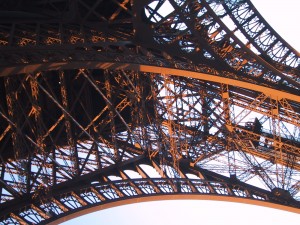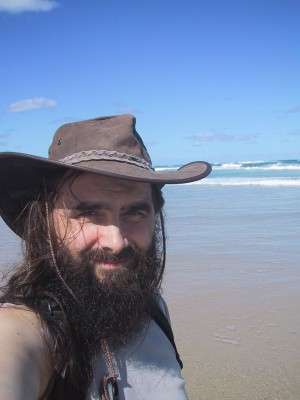I have just read Nic Bidwell and David Browning’s paper “Making There: Methods To Uncover Egocentric Experience in a Dialogic of Natural Places” (OZCHI ’06, pp.229-236, doi: 10.1145/1228175.1228216). It discusses two studies focused on the phenomenological experience of natural places, and in particular while walking in those places. Nic pointed me to this paper after I finished my notes of the APCHI / India HCI keynote, and I am sure it will influence further reflections on the Wales walk.
Reading it I cannot help but compare to my own experiences as walker, but of a very different kind, the vista of the long-distance voyeur rather than the familiarity of the local. Nature is personal and social, and yet impersonal and uncaring, place and non-place, parochial and universal.
Starting with the paper itself; the first study in the paper involved giving walkers head-mounted cameras during a woodland walk. Now-a-days there are off-the-shelf products, but at that point, 2006, they had to hack up their own Heath Robinson-like assembly of spy-cam, microphone and video recorders in a rucksack, typical of ubicomp research at the time. The second study asked attendees at an art in the forest event to gather an object during a short walk and then describe its meaning.
the alterity of place
The paper makes frequent reference to notions of ‘place’, developed in human geography and brought by Harrison and Dourish into HCI1. That is not simply cartographic ‘space’, Cartesian points on a map, but areas vested with social significance.
This was certainly relevant to the data from the first study where participants reminiscences were triggered by landmarks, some obvious to the eye and others more personal. However, this was specifically aimed at understanding ‘belonging to a community through its natural landscape’; the site for the walk was chosen ‘based on proximity, and familiarity with all participants.
Harrison and Dourish’s concept of place was influenced by Yi-Fu Tuan’s “Space and Place. The Perspective of Experience“, (University of Minnesota Press, 1977). He says:
“Place can be defined in a variety of ways. Among them is this: place is whatever stable object catches our attention. As we look at a panoramic scene our eyes pause at points of interest. Each pause is time enough to create an image of place that looms large momentarily in our view.” (p.161)
One of Bidwell and Browning’s participants was surprised that a major landmark, which appeared large in his mental image, looked “not much more than a pimple” in the video footage (p,233/234). The subjective ‘looming large’, is not captured by the ‘egocentric Point-of-View’ camera; the technological ‘infinite archive’2 captures sensation, but not perception.
 It is interesting that some of the markers that give us a sense of place are remote: the Eiffel Tower in Paris, the Empire State Building in New York, Tower Bridge or Buckingham Palace in London. I have taken the lift to the very top of the Empire State building, but only stood underneath the Eiffel Tower, and yet each has significance to my notions of New York an Paris as place. Similarly in London I have only in the last month crossed, or even been close to, Tower Bridge, and I have never been inside Buckingham Palace, and yet these are central to my personal concept of London. There is surely some weird alterity here in that we often define a place by the landmarks seen from it, rather than the ground beneath our feet.
It is interesting that some of the markers that give us a sense of place are remote: the Eiffel Tower in Paris, the Empire State Building in New York, Tower Bridge or Buckingham Palace in London. I have taken the lift to the very top of the Empire State building, but only stood underneath the Eiffel Tower, and yet each has significance to my notions of New York an Paris as place. Similarly in London I have only in the last month crossed, or even been close to, Tower Bridge, and I have never been inside Buckingham Palace, and yet these are central to my personal concept of London. There is surely some weird alterity here in that we often define a place by the landmarks seen from it, rather than the ground beneath our feet.
 Walking the north east coast of Anglesey, Wylfa Nuclear Power Station dominates the view for miles in each direction, its remorseless concrete cube casting a palid glow on rocks, sea, gravestone, and dead-fir copse (see day 33 and day 35). And yet close by, it becomes invisible, a double fence of razor wire, the hum of transformers, and a nature walk. To see it close to, you must enter the visitor centre, as if, like the nuclear fires within, its outer shape can only be seen in simulacrum, and yet the visitor centre is closed to those with muddy boots, the walker in the land is excluded and only those who come by car from afar welcome.
Walking the north east coast of Anglesey, Wylfa Nuclear Power Station dominates the view for miles in each direction, its remorseless concrete cube casting a palid glow on rocks, sea, gravestone, and dead-fir copse (see day 33 and day 35). And yet close by, it becomes invisible, a double fence of razor wire, the hum of transformers, and a nature walk. To see it close to, you must enter the visitor centre, as if, like the nuclear fires within, its outer shape can only be seen in simulacrum, and yet the visitor centre is closed to those with muddy boots, the walker in the land is excluded and only those who come by car from afar welcome.
forgotten places
The quote from Tuan is at the beginning of a chapter entitled “Visibiity: the Creation of Place”. Bidwell and Browning’s paper’s title starts “Making There”, both emphasising the conceptual construction of a sense of place. In one of Tuan’s examples (p.169–171), Boston’s West End is to be demolished and yet the activists speaking up for it were “artists and intellectuals” as the idea of the neighbourhood of the West End was foreign to most of its residents. Each felt passionately about their particular street, but had no concept of the larger area. It was only through the campaign that it became, metaphorically, ‘visible’ and so the idea of the neighbourhood and the ‘place’ were created.
But, if place is constructed, what of its dissolution?
When walking, I sometimes became a little blasé to beauty, “another cove, another headland, another craggy cliff face.” I have spent my whole life wishing to get away from the built environment, a Rousseau-esque idea of the noble savage almost before I could read. And yet, in my own walking, it was the points of human habitation and intervention that were the points of growth. This is partly the obvious ‘places’, seaside towns and villages where, as passer-by and dilettante, I sought to make sense of locality and community. However, there are also the forgotten places, the remnants, the ruins, the abandoned workings and redundant factories.
To be honest I enjoy these sites purely for the joy of abandonment, the aesthetic of desolation. However, there is also a desire to know more or simply fantasize about the people who lived and worked here before leaving their homes and work places, like their own bodies, to decay and dust.
Many of these sites had information boards telling stories of the past and on Tiree I’ve been involved in efforts to make the extensive local archive available online in mobile app Frasan (meaning ‘seeds’ or ‘shower’ in Gaelic). We cling to the memories of the past even when they are not our own.
 Walking east from Llanelli (see day 85) I passed a plaque to the ‘lost’ village of Bwlch y Gwynt, “circa 1880–1973“, a community that dissolved after the closing of the tinplate works that had dominated the landscape and economy for more than a century. It seems odd that a community can get ‘lost’ in my own lifetime, and yet that sense of loss has moved others to form an ‘Abandoned Communities‘ web site.
Walking east from Llanelli (see day 85) I passed a plaque to the ‘lost’ village of Bwlch y Gwynt, “circa 1880–1973“, a community that dissolved after the closing of the tinplate works that had dominated the landscape and economy for more than a century. It seems odd that a community can get ‘lost’ in my own lifetime, and yet that sense of loss has moved others to form an ‘Abandoned Communities‘ web site.
I have also been reading Bell’s analysis of the ‘infinite archive’, alluded to earlier, and a recurrent theme in digital humanities. Bell’s article starts with Derrida’s “Mal d’archive” (1995) and Nora’s vast ‘Lieux de Mémoire‘, project, which sought to document exhaustively the ‘sites of memory’ in France. Bell, interpreting Derrida, sees the focus on the ‘archive’ as symptomatic of a fear of loss, and according to Nancy Wood, another commentator, Nora saw the “lieux de memoire” as “themselves the impoverished substitutes of the “milieux de memoire,” “environments of memory,” which have all but disappeared”3. Is the love of heritage and desire to record no more than a clawing at our graves, fighting the inevitable progress to death symbolised by the burial of our own memory?
wilderness and self
The participants in Bidwell and Browning’s first study were at a place of familiarity, but there is also a tradition of seeking true wilderness, places without memories, or at least without our own memories.
We often talk of people ‘being alone with themselves’ in nature, and there is a truth in this, a time to ponder, to contemplate, almost easier in places not too replete with memories to intrude or direct.
Nora, in an apologetic for the ‘ Lieux de Mémoire’ project says that4:
“Modern memory is, above all, archival. It relies entirely on the materiality of the trace, the immediacy of the recording, the visibility of the image. What began as writing ends as high fidelity and tape recording. The less memory is experienced from the inside the more it exists only through its exterior scaffolding and outward sign” (p.13)
In the wilderness, in the absence of this external scaffolding we are free to experience memory more directly, more starkly, supported only by our own non-archival minds; for once experienced ‘from the inside’.
Or perhaps not?
In a way wilderness, places without personal significance, places that are place-less to you, open space; these places, in taking away the external props, can lead you not to be alone with yourself, but to be alone without oneself. To the extent that our notion of self is a construct of our own personal histories, in these spaces without ‘lieux de mémoire’ we are in some sense cast adrift or perhaps cut loose.
Bidwell and Browning’s studies are set in Queensland, Australia, a land where land and culture are deeply entwined, for the aboriginal inhabitants, but, in large part, apparently trackless and empty to Western eyes.
 I recall my first visit to Australia many years ago, to Melbourne in the South. After several heavy days of meetings we had a day off before the flight back to the UK. My colleagues wanted to go shopping, so I got the hire car to myself and set off to see Hanging Rock to the north and the apparently endless beach to the south west of the city.
I recall my first visit to Australia many years ago, to Melbourne in the South. After several heavy days of meetings we had a day off before the flight back to the UK. My colleagues wanted to go shopping, so I got the hire car to myself and set off to see Hanging Rock to the north and the apparently endless beach to the south west of the city.
As I walked the ground I felt the age of the rocks, rooted deeply into the fabric of the land, calling me, as if, when I stood still, the rock were creeping up my legs, so that I could become one with the land itself. I recall the spirits of the land in Patricia Wrightson’s Song of Wirrun trilogy; creatures of the rock, slowly moving, ageless. It were as if I could become like them transient flesh to eternal stone, and yet, in their age and primitive wisdom, did they lose something of the contingency and compassion of mortality?
But as well as that more transcendent yet earthy desire to lose myself in the land itself, I felt a more earthly temptation to abandon hire car and passport, to simply walk, a hobo traversing the empty places.
Of course, it is not just in nature that we can find such wilderness. Films and books return repeatedly to the trope of the urban wilderness, the allure of anonymity in the crowd, the desire to cut oneself off from the archive, authority and past. In anther recently read book, ‘All Things Betray Thee‘, the inhabitants of Moonlea long to destroy the hall that contains the records of their debts, although it is jealously guarded by clerk, Yeomanry and priest; the latter forgetting the one who battered down the gates of hell to wipe clean the debts of all. The record of things past can be a heavy weight.
Augé’s Non-places considers malls and airports, vanilla spaces without the social history to make them places. Yet maybe it is this that is part of their appeal, satisfying for the modern consumer the same urge that led the inhabitants of Moonlea to throw themselves vainly and bloodily into the Yeomanry’s musket fire or that led the heroes of spaghetti westerns into the desert.
the universality of the particular
Bidwell and Browning’s second study was also with people local to the area. However they were at an event and in particular an arts workshop, which will have changed their perspective. The data gathering was also focused around found objects, what Bidwell and Browning call nature probes’.
It maybe the object-centric, event-based or arts-focused nature of the study, or some combination of all, however, whatever the cause, in addition to very situated comments, there were also more personal and crucially less-site specific ones:
“… a participant compared the unobtrusive slender leaf to herself “during in the week” but its dazzling, coloured tip to herself “at a party”.” (p.234)
The leaf could have been a leaf anywhere.
I walked on a number of long beaches: Hells Mouth in the Lleyn Peninsula, the endless sands north of Aberdyfi, and more. Most I have never been to before, and yet there was always a sense of nostalgia, and déjà vu, of coming home. I think they conjured up remembered and half-remembered feelings of childhood seaside holidays, even though the beaches I actually visited as a child often evoked less visceral feelings. Perhaps the idea is more solid than reality.
Indeed, there is something about the universality of the particular: each tree becomes every tree, each leaf, every leaf.
 Some years ago, when giving a keynote at a workshop of Space and Spatiality, I used my own childhood memories of growing up in Cardiff, the way my infant mind gradually joined together the scattered jigsaw pieces of experience, threaded them like a toy necklace, and eventually laid them flat in mental maps5.
Some years ago, when giving a keynote at a workshop of Space and Spatiality, I used my own childhood memories of growing up in Cardiff, the way my infant mind gradually joined together the scattered jigsaw pieces of experience, threaded them like a toy necklace, and eventually laid them flat in mental maps5.
I had feared that this personal reminiscence would be too self-indulgent, and yet quite the opposite, so many people were touched — my own, very personal story struck chords in others, reconnecting them each to their own childhood.
And this is some of the power of the wilderness, bereft of particular memories, it becomes all our memories.
- Harrison, S. and Dourish, P. 1996. ‘Re-Place-ing Space: The Roles of Space and Place in Collaborative Systems’. CSCW’96, ACM. doi: 10.1145/240080.240193. Dourish, P. ‘Re-space-ing place: “place” and “space” ten years on’, Proceedings of the 2006 20th anniversary conference on Computer supported cooperative work, November 04-08, 2006, Banff, Alberta, Canada. doi: 10.1145/1180875.1180921.[back]
- See David F. Bell, ‘Infinite Archives’, SubStance, Issue 105 (Volume 33, Number 3), 2004. pp. 148-161, doi: 10.1353/sub.2004.0034[back]
- Nancy Wood. ‘Memory’s Remains: Les lieux de mémoire’. History and Memory. Vol. 6, No. 1 (Spring – Summer, 1994), pp. 123-149. Indiana University Press http://www.jstor.org/stable/25618664[back]
- Nora, P. (1989) ‘Between Memory and History: Les Lieux de Mémoire’, Representations 26, 7–25. http://www.history.ucsb.edu/faculty/marcuse/classes/201/articles/89NoraLieuxIntroRepresentations.pdf[back]
- A. Dix (2004). Paths and Patches – patterns of geognosy and gnosis. In Spaces, Spatiality and Technology. Napier University Edinburgh. http://www.hcibook.com/alan/papers/space2-2004/[back]
